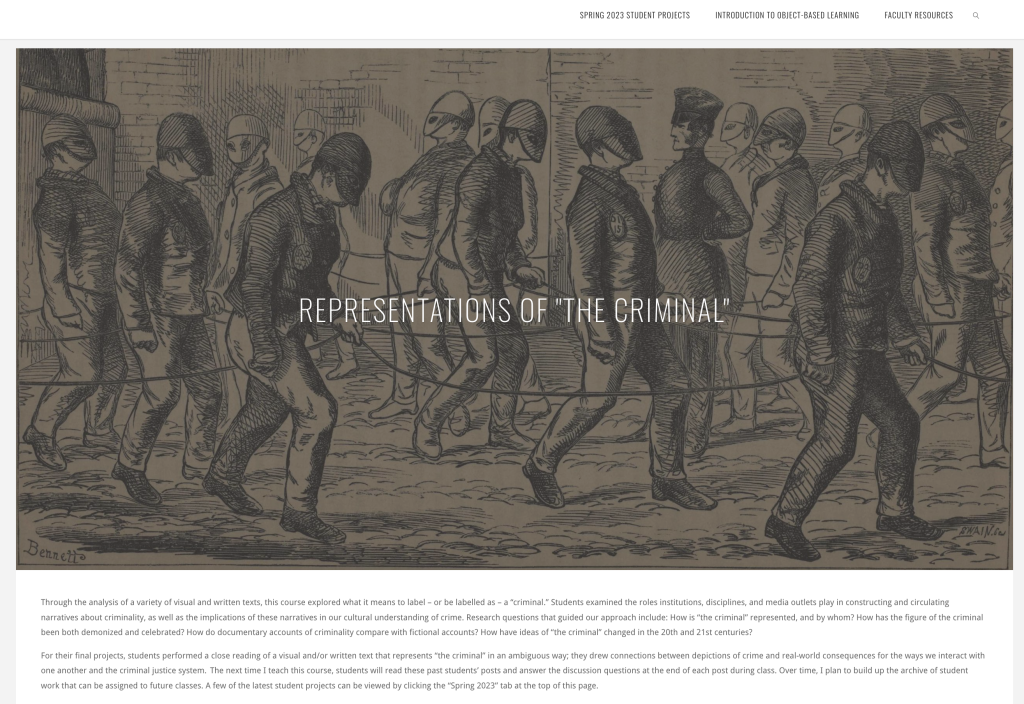My initial proposal for the Open Pedagogy Fellowship was to refine a student-led class activity I developed for my upper-level literature course, “Representations of ‘the Criminal.’” However, the conversations I had with my Open Pedagogy Fellowship cohort over the summer of 2022 inspired me to pursue an additional, more extensive project to build a website with my class. I thoroughly enjoyed seeing other faculty members’ projects develop, and the extensive work done by previous Open Pedagogy Fellows was incredibly creative and engaging. I wanted to seize the opportunity to make an open educational resource that I could build on during each subsequent semester I teach my course.

I collaborated with an undergraduate student, Muntasir Hossain, on my initial plan to revise the student-led discussion assignment. This was the second time I’ve worked with a student to refine my course materials, and Muntasir provided excellent advice for clarifying the assignment guidelines and building a grading structure that would be rigorous without being burdensome for students. We also brainstormed ideas for the website, and he helped me create an additional, new assignment that would allow current students to share their work publicly and allow future students to engage with that work as part of class discussion.
For the website, I asked students to perform a close reading of a visual and/or written text that represents “the criminal” in an ambiguous way; they drew connections between depictions of crime and real-world consequences for the ways we interact with one another and the criminal justice system. The next time I teach this course, students will read these past students’ posts and answer the discussion questions at the end of each post during class. Over time, I plan to build up the archive of student work that can be assigned to future classes. A few of the latest student projects can be viewed by clicking the “Spring 2023” tab at the top of the homepage.
I have experience building websites, but I haven’t done so in collaboration with students. Because I scheduled the website project at the end of the semester when I had already developed rapport with my students, they were open to trying something that was new not only to them, but also to me. I was impressed with how quickly they began designing their webpages after just a few brief instructions. The final products demonstrate a careful awareness of audience and a willingness to take creative risks.
A major component of my course was a series of field trips to the Yale art galleries and Beinecke library, and I felt the website wouldn’t be complete without a page of resources to encourage faculty to take their students on similar trips. Scheduling, planning, and funding the trips is a significant time investment, and I wanted to share the many tips and tricks I discovered for streamlining the process. On the website, I included a page, “Introduction to Object-Based Learning,” that discusses the methodology I use when teaching students to look at and analyze art. Additionally, the “Faculty Resources” page breaks down the complicated process of arranging a field trip.
My final project for the Open Pedagogy Fellowship went well beyond what I had initially planned, and that is entirely due to the rich conversations I had with colleagues over the first summer of the fellowship. This experience has shown me firsthand how a simple set of conversations with colleagues can lead to innovation and interdisciplinary collaboration. I hope that the course website for “Representations of ‘the Criminal’” will encourage other faculty to collaborate with their students on open educational projects and that it serves as an inspiration for those who want to tackle the daunting task of taking students on field trips.
